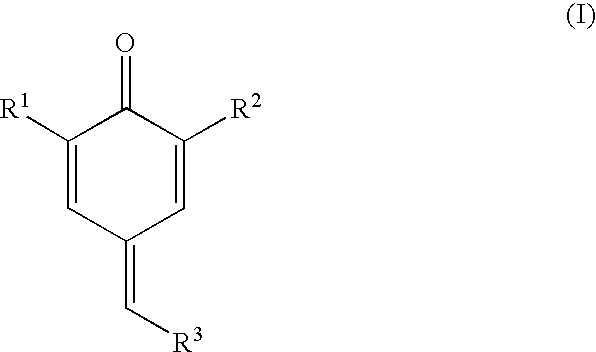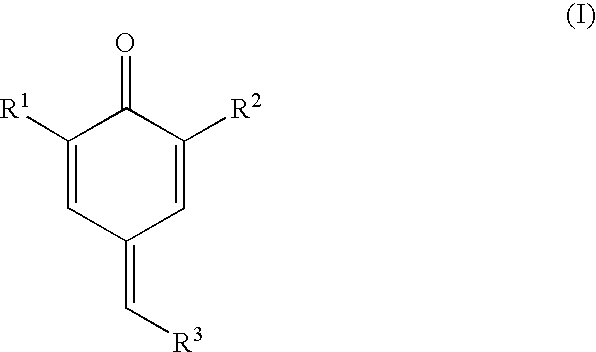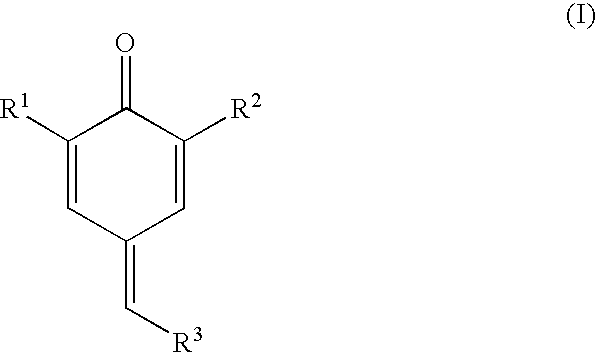Inhibition of viscosity increase and fouling in hydrocarbon streams including unsaturation
a technology of unsaturated monomers and hydrocarbons, which is applied in the direction of thermal non-catalytic cracking, separation processes, fuels, etc., can solve the problems of increasing the viscosity of hydrocarbons present in the bottom section of the tower, fouling, adversely affecting the quality of the final product, etc., and achieves the inhibition of inhibiting fouling and viscosity increase, and inhibiting fouling and vis
- Summary
- Abstract
- Description
- Claims
- Application Information
AI Technical Summary
Benefits of technology
Problems solved by technology
Method used
Image
Examples
example 1
[0021]Py-gas oil viscosity was measured at 20° C. after being heated at 150° C. for 7.5 hours. Three trials were performed; one blank, the second with 1000 ppm phenylenediamine, and the third according to the inventive method including 1000 ppm of the quinone methide of formula (II), above. Table 1 below demonstrates that the viscosity of the py-gas oil after treatment with the inventive quinone methide was 43.6% less than after treatment with phenylenediamine alone, and 55.1% less than the blank after the py-gas oil was subjected to conditions simulating those in an oil quench tower.
[0022]
TABLE 1Treatment NameViscosity (cst)Blank4.9PDA (44 PD1)3.9Quinone Methide (II)2.21N,N′-di-sec-butyl-p-phenylenediamine available from Flexsys
example 2
[0023]Py-gas oil viscosity at 23° C. was measured after being heated at 144° C. for six hours with the amounts of treatment listed in Table 2. This demonstrates that up to a concentration of 2000 ppm, a greater concentration of the inventive quinone methide treatment provides an enhanced inhibition of viscosity increase.
[0024]
TABLE 2Quinone Methide (II)ViscosityTreatment (ppm)(cst)01.635001.3910001.2020001.13
example 3
[0025]The polymer content in py-gas oil samples was measured by methanol precipitation after heating at 150° C. for 7.5 hours. Three trials were performed; one blank, the second with 1000 ppm phenylenediamine, and the third according to the inventive method including 1000 ppm of the quinone methide of formula (II), above. The results in Table 3 indicate that the polymer content of the py-gas oil samples after treatment with the inventive quinone methide was 32.3% less than the after treatment with phenylenediamine alone, and 40.0% less than the blank after the py-gas oil was subjected to conditions simulating those in an oil quench tower.
[0026]
TABLE 3PolymerTreatment NameContent %Blank4.0PDA (44 PD1)3.1Quinone Methide (II)2.41N,N′-di-sec-butyl-p-phenylenediamine available from Flexsys
PUM
| Property | Measurement | Unit |
|---|---|---|
| viscosity | aaaaa | aaaaa |
| temperatures | aaaaa | aaaaa |
| concentrations | aaaaa | aaaaa |
Abstract
Description
Claims
Application Information
 Login to View More
Login to View More - R&D
- Intellectual Property
- Life Sciences
- Materials
- Tech Scout
- Unparalleled Data Quality
- Higher Quality Content
- 60% Fewer Hallucinations
Browse by: Latest US Patents, China's latest patents, Technical Efficacy Thesaurus, Application Domain, Technology Topic, Popular Technical Reports.
© 2025 PatSnap. All rights reserved.Legal|Privacy policy|Modern Slavery Act Transparency Statement|Sitemap|About US| Contact US: help@patsnap.com



